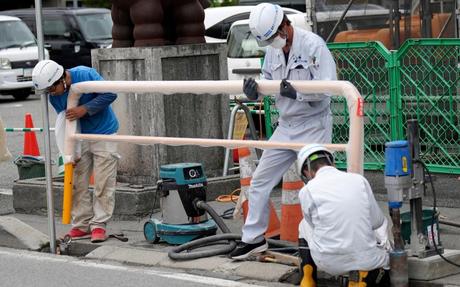For the Japanese poet Basho, Mount Fuji was a muse like no other. He returned to it numerous times during his lifetime and described "through clouds and mist, a hundred views" of the volcano.
The 17th century writer might have been alarmed to learn that there is now one fewer viewing point. This week, officials in the small town of Fujikawaguchiko - at the foot of the mountain - began blocking the view with a mesh net.
The scene is atypical: in the foreground the neon sign of a Lawson supermarket, typical of such cities in Japan, and the serene mountain behind it. Not an absolutely sublime recording, but something more complicated - and, according to the locals, far too popular.
In an attempt to get the most impressive photo, visitors have reportedly climbed over rooftops and obstructed traffic, despite signage convincing them otherwise. "It is regrettable that we have to do this because some tourists cannot respect the rules," an official spokesperson said.

This move is just one of many guerrilla attempts by locals to stop tourist misbehavior in their towns. These interventions are often carried out at a micro level and are as much about venting frustration as about banning holidaymakers.
Take Portofino, the charming seaside town on the Italian Riviera. After hordes of visitors blocked the sidewalks, disrupted the cobblestone streets and took loads of selfies, officials set up "waiting bans" in the most photogenic spots.
The areas carry fines of €275 and are designed to punish out-of-town loiterers (and stop the endless flow of Instagram-inspired visits). It's a rather crude resolution, but one that locals fed up with the takeover have roundly welcomed.
A fake infection
Elsewhere, the measures were less official. Last year, Paris was ravaged by a bedbug plague. Commentators warned of bug-infested hotel rooms; it was suggested that the mites had crossed the Channel and were working their way through British transport systems.
Cleverly, the jaded residents of Athens took the opportunity to warn travelers about their own infestation problem, posting stickers warning of insects in popular neighborhoods. The catch, of course, was that there were no marauding insects - just frustration with the seven million non-resident human visitors who poured into the city last summer.
Self-adhesive campaigns have stuck. A similar hostile campaign has led to locals putting 'tourists go home' stickers on walls in central Malaga. Properties in the city are increasingly being converted into short-term rentals for visitors and 'digital nomads', who are attracted to the low cost of living in southern Spain.
Phrases such as "before this was my house" and "a family lived here" are intended to inform tourists - in no uncertain terms - about the negative impact of their presence.
The Iberian outrage looks set to continue this summer as nationwide droughts threaten holiday plans. On the mainland, hotels are expected to have to limit the amount of water they use in the warmer months (public services, such as beach showers and swimming pools, are already closed). It's not enough for the locals.
Last month, a series of protests took place in the Canary Islands, with residents complaining in various ways about hotel construction, water use and widespread pollution. Reports of local people living in caves and cars and unable to afford housing have fueled matters further.
The disappearing bus
But back to the mainland, for a more clandestine anti-tourism measure. In April it was noted that the often busy bus route 116 - which ran between the city center and the popular Park Guell - had disappeared from online maps. The bus itself had not been canceled, but after the service was so crippled by demand that locals could essentially no longer use it, city officials decided to remove it from public view.
"We had to remove references to it on the internet," said one city councilor, refusing to confirm who exactly was behind the measure. It seems to be the culmination of local action; graffiti in the city has long drawn tourists away from the Gaudi-designed park.
In some locations, the British are mainly seen as the problem. For bachelor night favorite Amsterdam, attracting foreign visitors is no longer seen as a priority, neither by residents nor by city officials. A new campaign, released on a website called "Amsterdam Rules" and currently only shown to visitors from Britain, features a survey that aims to "discourage a specific type of tourist from coming to Amsterdam".
Regardless, drunk Brits keep visiting. Join 'Stop de Getke' ('Stop the Madness'), a grassroots campaign where members patrol the city streets and document indiscretions in the red light district and beyond. The campaign hopes to put pressure on officials to take more anti-tourism measures.
Inspiration could be found in Venice, the example of overtourism. Calls to limit numbers have ultimately resulted in an entrance fee for day trippers. It's not enough for locals, who marched in protest on the first day. For them, the €5 ticket price will do nothing to discourage the 30 million visitors a year, reducing them to a theme park in the process.
Such conflicts are obviously complicated. Although visitors may flood a city in the summer, their business is vital to the economy: the infrastructure of a place like Santorini, for example, relies heavily on the money of foreigners. An estimated 975 million tourists traveled internationally between January and September 2023, according to the UNWTO.
It is believed that this number will be even higher by 2024. Tourists are not retreating, but are exploring more than ever - and are increasingly heading to the same places. With clashes between locals and tourists sure to continue, we can expect more guerrilla campaigns in the coming months.
